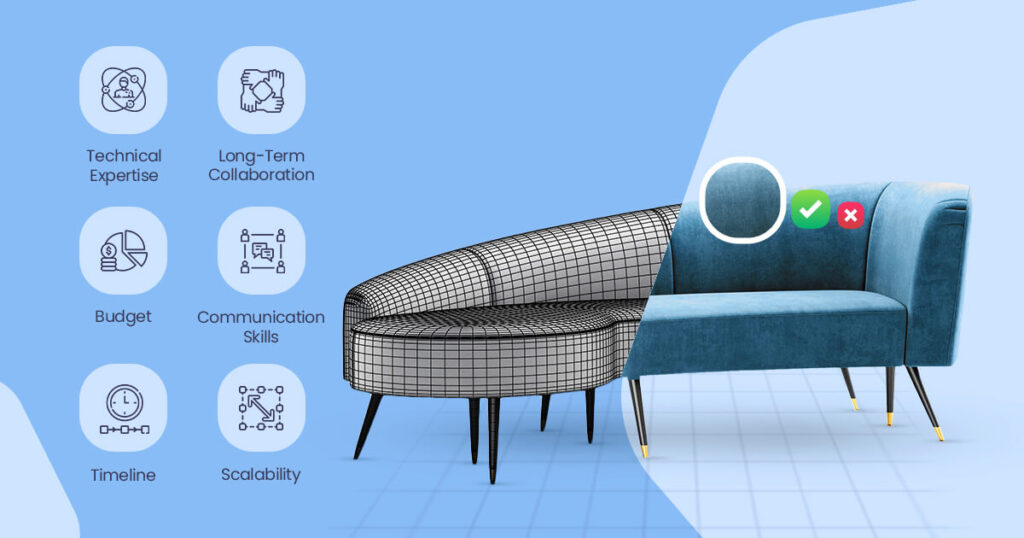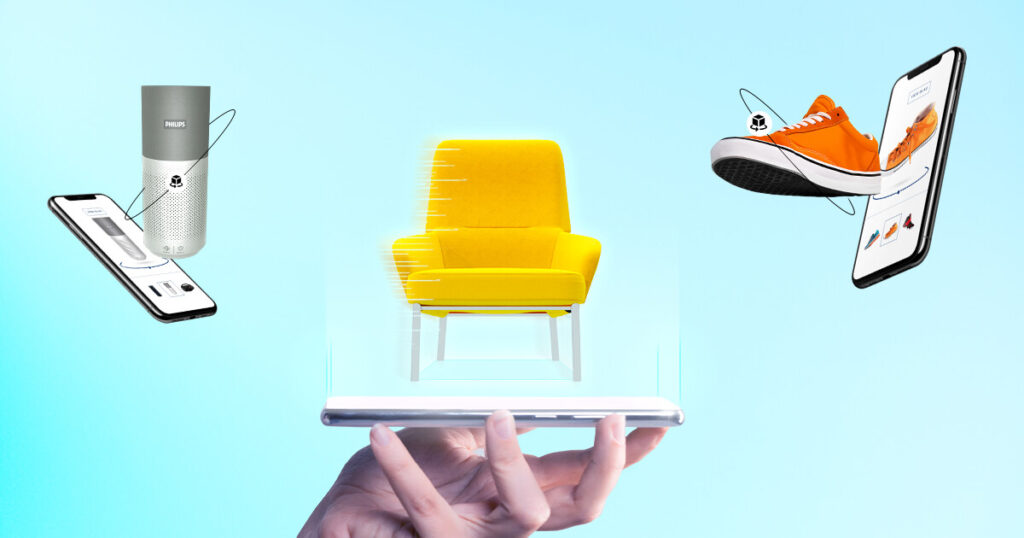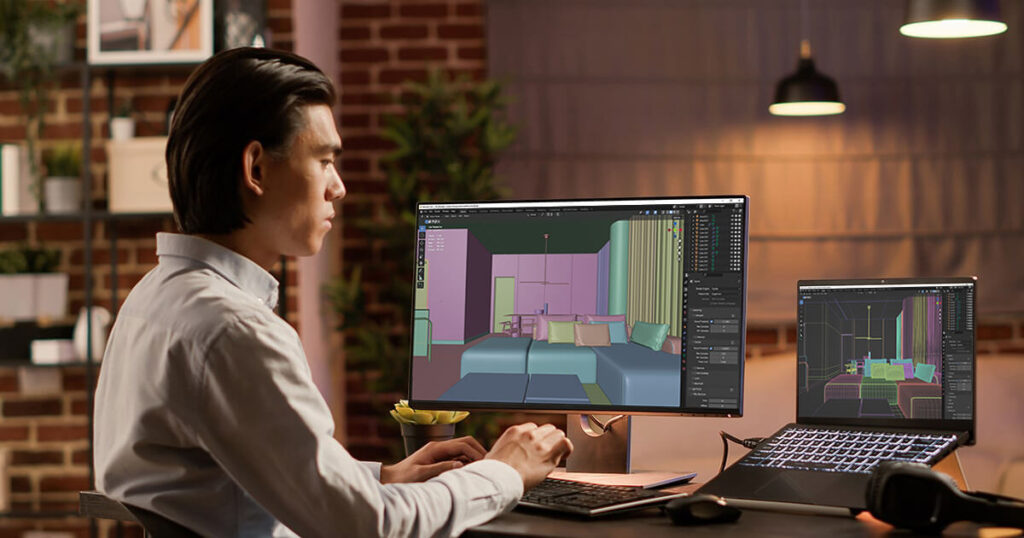The 3D e-commerce landscape is booming and consumers increasingly moving online marketplace to their shopping needs. While this convenience is undeniable, but there’s an obstacle. That is physically interacting with products before buying. This can lead to uncertainty and hesitation. It creates an impact on conversion rates.
This is where the ground-breaking technology of 3D e-commerce comes into play. The integration of 3D models into an online store can break the gap between the physical and digital shopping experience. Customers can rotate the furniture product and zoom in on the intricate details. Through AR technology customer can see the furniture product in their own homes. These are all possible through 3D e-commerce. This improves a lot in the shopping experience.
Benefits of 3D E-Commerce
There are so many benefits to 3D e-commerce. From 3D visualizations to customer engagement, so many benefits that 3D e-commerce brings to the table for both businesses and consumers:
- Increased Conversion Rates: 3D models offer a realistic and interactive product experience. Purchase hesitancy can be greatly decreased with 3D models, which gives customers more confidence and raises conversion rates.
- Reduced Return Rates: Customers can inspect products in detail in three dimensions through 3D product models. It reduces the possibility of receiving a product that falls short of their expectations. Fewer returns and happier customers are the results of this.
- Customer Engagement: 3D models are created in fascinating nature. 3D models enable customers to explore product features and details dynamically by keeping them on product pages for longer.
- Improved Brand Image: Implementing modern technology like 3D helps to showcase the brand’s commitment to innovation and customer experience. It sets the apart from the competition.
- Reduced Purchase Anxiety: Online shopping becomes less uncertain when using 3D models, which offer an interactive and detailed product experience. Before making a purchase, customers can be certain of what they’re getting.
- Enhanced Visualization: Envision virtually setting up a new sofa in your living room. Customers can see how products will fit and appear in their own spaces with the help of 3D models.
In essence, 3D e-commerce benefits all parties involved. It enables e-commerce businesses to showcase their products engagingly. It increases sales and satisfies customers. That’s the power of 3D e-commerce.
7 Powerful Strategies to Boost Conversions with 3D E-Commerce
Companies can provide a new level of digital media product management by integrating 3D models. As we know there are many benefits of 3D e-commerce. Let’s talk about 7 powerful strategies to boost conversions with 3D e-commerce.
Product Details in Stunning High-Definition
The drawbacks of flat product images are undeniable. Since a single image can only show a single point of view, consumers are left wanting to learn more in-depth details about the products they are considering. Translation frequently loses important details, such as intricate patterns, tactile materials, or the overall three-dimensionality of a product. This lack of knowledge could make customers hesitant, which would hurt sales.
The game-changer is 3D e-commerce. High-quality 3D models let buyers virtually “touch” and examine items from every angle. Within the digital realm, they can examine the weave of a fabric, rotate a piece of furniture to view its back or zoom in on minute details of a watch’s mechanism. Like in-store interactions, this degree of interaction helps consumers feel comfortable and confident using the product.
Improve Product Experiences
Although 3D models with high definition are an effective tool, 3D e-commerce presents even more opportunities for producing genuinely immersive product experiences. Let’s see some strategies for improving customer interaction:
- Interactive 3D Experiences: Imagine that a customer can virtually “try” a cabinet, open and close a dresser’s drawers, and examine the tread pattern from various perspectives, all within the confines of a web page. A more memorable shopping experience is produced by this degree of interaction, which develops a feeling of connection with the product.
- The Power of 360° Views and AR Placement: 360° views can be added to 3D models to enable customers to view the product piece from all sides. The placement of Augmented Reality (AR) is even more amazing. Consider a consumer who virtually places a 3D model of a couch in their living room with their phone to make sure it fits properly before making a purchase. This gets rid of the uncertainty and nervousness that come with buying furniture.
- Product Configurators for Customization: 3D configurators are revolutionary for products that provide customization choices. Within the 3D model, customers can select the materials, colors, and finishes of their choice and view real-time updates of the product. Customers feel confident and take ownership of their purchases when they receive this level of personalization.
Boosting Customer Confidence with Visual Understanding
There is a direct correlation between low product visualization and dissatisfied customers. Imagine placing an online order for some amazing-looking furniture, only to find out when it arrives that it doesn’t fit properly. As an alternative, you could order a bookshelf that fits only a portion of your collection despite appearing large in online photos. These circumstances, which arise from a hazy grasp of the product, lead to returns and unhappy customers.
This issue is resolved by 3D e-commerce, which offers a precise and lifelike representation of the products. In contrast to flat photos, which may warp proportions, 3D models accurately show the size of a product. Consumers can see how a piece of furniture will fit in their room, see how clothes will fit on various body shapes, or even gauge how big a phone will be in relation to familiar objects.
Storytelling Through 3D
Let’s face the traditional photography. It can be lifeless and impersonal. They frequently concentrate on technical details, which makes it difficult for buyers to emotionally connect with the product. This is where the strong storytelling of 3D e-commerce comes into play.
A customer sees a 3D model of a comfortable armchair next to a crackling fireplace in a tastefully decorated living room, rather than a static image and a bulleted list of features. This scene tells a story while instilling a sense of comfort and relaxation in the viewer, enabling them to picture themselves using the product at home.
Beyond still images, 3D models are extremely powerful. It’s easy to demonstrate furniture’s functionality with animation. Consider a 3D representation of a sofa that can be easily converted from a couch to a bed. Alternatively, a recliner that moves to show off its different reclining positions. These eye-catching graphics not only draw in viewers but also effectively convey the qualities and advantages of the product, making a lasting impression on them.
Better Customer Journey with Visual Answers
There are so many online stores that don’t have much information regarding the particular product. Some online stores have inaccurate information about the product. Customers may find their experience frustrating if they receive inaccurate information, especially when it comes to size, dimensions, or materials. This causes customers not to want to buy and complicates the buying process even further.
3D e-commerce offers a solution by offering customers a visual answer to commonly asked questions. Good 3D models make it easy to communicate a product’s dimensions; you no longer have to decipher cryptic measurements from product descriptions. Customers can zoom in to examine textures and materials, so in-depth explanations are not necessary. A window with precise measurements or a close-up of the opulent leather upholstery may show when your cursor is over a 3D model of a couch.
This level of visual communication streamlines the purchasing process and eases the workload for customer support staff by enabling customers to locate the information they require on their own. 3D e-commerce encourages a more knowledgeable and assured purchasing experience by offering succinct and clear visual responses.
Optimizing for the Mobile-First Shopping Experience
It’s true that our shopping habits have changed. Consumers are increasingly using their phones and tablets to browse and buy products because they have become an extension of themselves. Indeed, Mobile devices make up 60% of all e-commerce sales globally as of July 2023. Serving the needs of the mobile-first consumer is becoming a must for e-commerce companies to succeed.
This is the sweet spot for 3D e-commerce. On mobile screens, traditional product images are frequently awkward and unwieldy. But shopping with 3D models made especially for mobile devices is smooth and entertaining. Imagine a customer using their phone to browse furniture being able to easily rotate a 3D model of a chair to view all of its fine details, all contained within the small screen of the device.
The secret is to use 3D model formats that have been optimized to guarantee responsive interaction and fast loading times on mobile devices. For this reason, formats like glTF and Draco were created expressly to let users take advantage of the power of 3D e-commerce on any device. Businesses can reach the constantly expanding mobile audience and increase conversions while on the go by giving priority to mobile-friendly 3D models.
Data-Driven Approach Through A/B Testing
There is much more that 3D e-commerce can do than just create visually striking products. It also gives you insightful data that you can use to improve your strategy over time and make it more effective. One essential tool in this process is A/B testing.
A/B testing can be used to compare which version of a product page is performing better. Consider the comparison interactive 3D model of a sofa that allows users to rotate and magnify specific details with a static model. You can learn a lot about how users interact with 3D models and identify the most engaging features by examining data about metrics like time on page, click-through rates, and conversions.
A/B testing is more powerful than a single experiment. You can discover what 3D E-Commerce works best for your target market and products by testing and improving it continuously. With this data-driven approach, you can be sure that your 3D models are strategically optimized to increase conversions and provide the best possible customer experience in addition to being aesthetically pleasing.
Conclusion
The e-commerce sector is constantly changing and 3D e-commerce helps to improve customer engagement with products in the digital media. Furniture brands and e-commerce businesses can overcome the limitations of traditional online shopping by utilizing 3D models. In the end, 3D e-commerce can lower returns and increase customer confidence, which boosts conversions and helps you create a profitable online business.
Are you prepared to see your furniture brand transformed by 3D e-commerce? We at Orbe3D are experienced in creating eye-catching 3D visuals and models that will improve your online store to new heights. Get in touch with us right now to find out how we can assist you in developing an immersive and captivating shopping experience that increases revenue and pleases clients.





